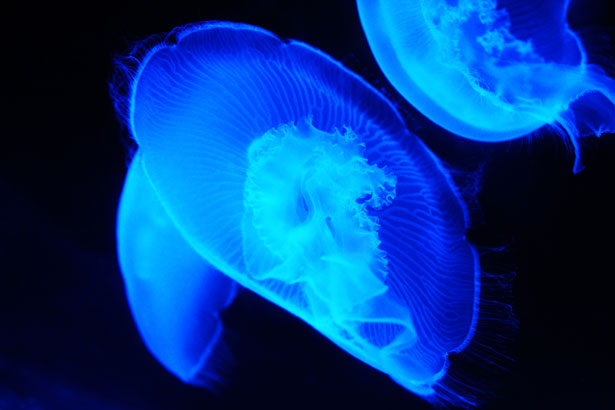ANIMAL: Common Moon Jellyfish Aurelia aurita Type of Animal: Ulmarid Jellyfish Habitat: Utilize salt & brackish water-Inshore/nearshore harbors, nearshore/inshore estuaries, bays, coastal waters, coastlines, inshore seas, inshore ocean areas, reefs, temperate seas/oceans w/ consistent currents, upwelling areas, ocean surfaces, open ocean, open waters, tropical waters, epipelagic zones, mesopelagic zones, beaches, occasionally found in freshwater lakes Location(s): Atlantic Ocean, Indian Ocean, Pacific Ocean-almost worldwide Appearance: Almost entirely translucent & has 4 horseshoe-shaped gonads, bell on top Food/Diet: Zooplankton, larvae, mollusks, crustaceans, small fish, rotifers, diatoms, protozoans, tunicate larvae, nematodes, young polychaetes, eggs, small comb jellies, small hydrozoans, small jellies, planktonic worms Status in Wild: Stable Lifestyle: Groups range from as few as 10 to as many as 5,000 Additional Info: Called: Adult: Medusa Young: Planula/Ephyra Group: Swarm/Bloom/Smack Diameter: Adult: 7-12 in Young: 0.39 in Gestation: 1 week Life Span: Medusa: 6-12 months Polyp: 1-25 years Height: 3 in Main predators are fish, sea turtles, birds, sea anemones, sharks, larger jellyfish, & marine mammals. Reproduces both asexually & sexually. Start life out as planulae resulting from sexual reproduction. Planulae attach themselves to surfaces, developing into polyps. Polyps reproduce asexually by budding forming entire colony. Some polyps produce juveniles known as ephyrae. These ephyrae become adults (medusae), which reproduce sexually. Most soon die after sexual reproduction starting cycle all over again. Since they don’t have lungs, they breathe through membrane. Short tentacles lined w/ nematocysts (stinging cells) used for catching prey/defense. Prey gets trapped in mucus coating animal & passed via cilia into oral cavity for digestion. Also called Moon Jelly, Common Jellyfish, Moon Jellyfish, & Saucer Jelly. Fun Fact(s): Sometimes eaten in parts of Asia. While found in water, they’re poor swimmers relying on ocean currents to move them. Asexual jellyfish can undergo lifecycle reversal, essentially becoming younger rather than older. They’re capable of extreme regeneration. While they can sting, these stings are usually only somewhat painful & not deadly. Most stings occur from someone touching one on the beach (even dead ones can sting). These animals made of 95% water, mouth, & digestive system. They don’t have blood/eyes/brains/ears/heart.
